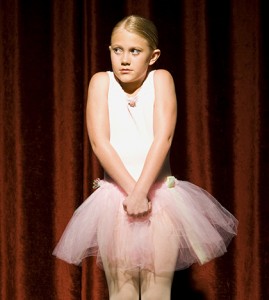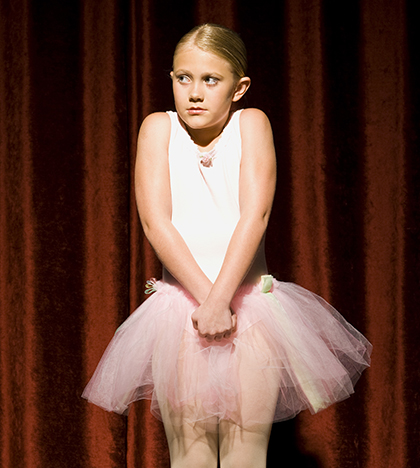Stage Fright! Tips to Help Your Students Enjoy Recital Time
By Angela D’Valda Sirico of Dance Teacher Web
 Performance anxiety can happen at any age and at any time. You have seen the student who has trouble getting out on stage or who runs off the stage during a performance. Usually, the preschool student’s performance anxiety manifests itself as a crying or shrieking event, and as the students get older, he or she may simply choose not to perform. That student can potentially be totally unable to remember their number when they are out in front of an audience or if they manage to get through their number, they may finish it just in time to run offstage to throw up. None of these situations are beneficial to the student, and by helping them to overcome their anxiety and fear, it will enable them to enjoy their love of dance without it becoming a traumatic situation every time they step out in front of an audience. By overcoming their fear, they will have a confidence that they have not felt previously, and it will be a life skill that will benefit them no matter what walk of life they choose to follow.
Performance anxiety can happen at any age and at any time. You have seen the student who has trouble getting out on stage or who runs off the stage during a performance. Usually, the preschool student’s performance anxiety manifests itself as a crying or shrieking event, and as the students get older, he or she may simply choose not to perform. That student can potentially be totally unable to remember their number when they are out in front of an audience or if they manage to get through their number, they may finish it just in time to run offstage to throw up. None of these situations are beneficial to the student, and by helping them to overcome their anxiety and fear, it will enable them to enjoy their love of dance without it becoming a traumatic situation every time they step out in front of an audience. By overcoming their fear, they will have a confidence that they have not felt previously, and it will be a life skill that will benefit them no matter what walk of life they choose to follow.
Any performer needs a certain amount of anxiety or feelings of nerves (often described as
“butterflies”) in order to have the adrenaline to get out on stage and make it work, but it is when the nerves take over in a negative way that the person starts to panic and fall apart. Practicing ways to be energized without anxiety need to first start in the classroom. As teachers, we can help our students to find ways to calm themselves sufficiently to be able to have a positive experience when they step out onto the stage. I always try to identify exactly what each student is most afraid of. In many cases, it is a fear of falling onstage or sometimes it is a fear of forgetting the choreography and making a fool of themselves. Once I have identified the problem, then it is much easier to move forward and help the student to regain their confidence and control of their feelings. Very often it is that feeling of being out of control or failing that terrifies some students. It is important to work in class to give the students an understanding of how they can fix their panic and go back to enjoying their dancing and any performances.
I myself found it very helpful when I was performing to have a certain ritual which I followed every day that I had a performance. I would always make sure that I was at the theatre or TV station well in advance of my call time. I would do a thorough warm up and then go to my dressing room to do hair and make-up. I didn’t want to have idle conversation with anyone I just wanted to calmly prepare myself without rushing so that I was able to focus on everything positive for my performance. That worked for me but, of course, everyone is different, and it doesn’t matter what you like to do as long as you have a plan to keep yourself calm.
[pullquote]When someone falls in class, I let them know that they obviously were trying very hard at whatever they were doing and that it is OK to fall without it becoming a major embarrassing moment. [/pullquote]
Addressing the issue of failing with your students is an important one. There is so much pressure nowadays for kids not to fail, as if it is a disgrace. What a shame that they are made to feel this way because it is really only by failing that you can find the path to success. I always tell my students that it is not the failing that is important it is how quickly and gracefully you can recover and carry on. Once they understand that premise, they will gradually be able to control their fear of performing. I also teach all my students how to fall in a relaxed manner so that they understand that they can slip and fall, make it look reasonably graceful and get up quickly so that they can continue their dance without completely freaking out! When someone falls in class, I let them know that they obviously were trying very hard at whatever they were doing and that it is OK to fall without it becoming a major embarrassing moment. You do, in fact need to fall to lose the fear of it. No one wants that to happen on stage but if it does having the confidence to go with it, get up and get on with it is a major boost to any dancer.
For some dancers it helps to keep something personal that makes them feel good in the dressing room. Perhaps it is a stuffed animal that they are particularly fond of or a picture of their pet or family. Whatever it is, if it helps to stabilize the nerves, it should be encouraged. Keeping everything positive is the most important lesson that you can teach your students. Our motto is simply “Make it work” and if they are able to do that, they will be successful no matter what line of work they eventually decide to do.
Try This:
Paste signs on the mirror or, even better, have them face the back of the room and tape them to the blank wall. These signs can be anything that will motivate or encourage the student to perform like “Express Yourself!” or “Let Loose!” or “Time to Shine!” You can let your imagination run wild on sayings that will remind the students that dance after all is a Performing Art. Without the performing, we have no art!
In class and rehearsal, encourage your students to take a chance. After all, that is a big part of what dance is about: having the freedom to go where others have not dared to go. To do whatever it takes to express yourself, to give joy to others, and to accept that failure is part of success. If we can send our students out into the world without a fear of performing or getting up in front of others, then we can truly say we have done our job. This is one of the wonderful gifts that dance teachers can give to their students, and one that will be remembered by them for their entire lifetime!



